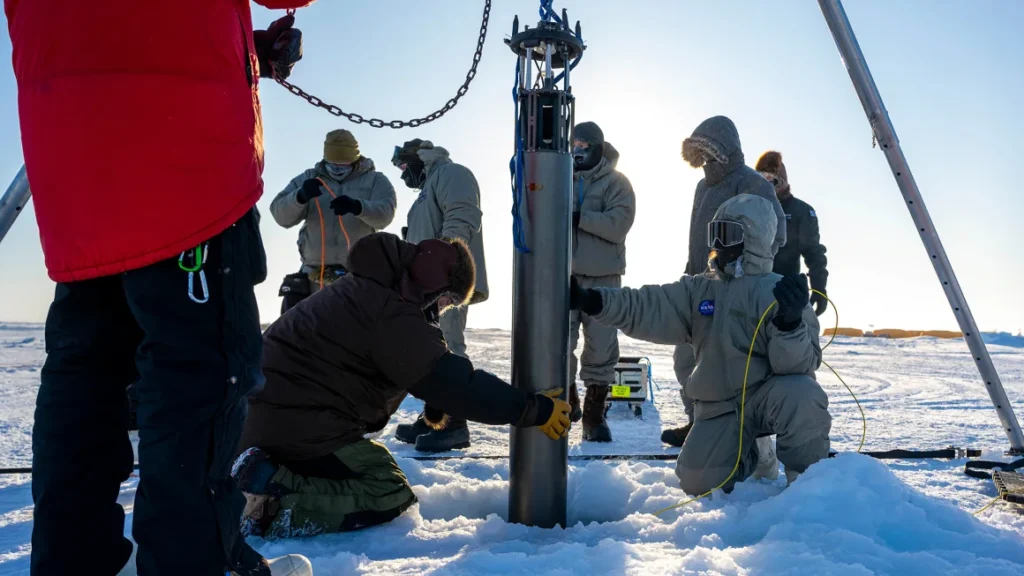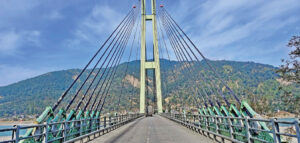
A group of NASA rocket researchers is creating independent submerged robots able to go where people cannot, profound underneath Antarctica’s mammoth ice racks. The robots’ errand is to superior get it how quickly ice is dissolving — and how rapidly that seem cause disastrous ocean level rise.
In Walk, researchers from NASA’s Fly Drive Research facility brought down a round and hollow robot into the frosty waters of the Beaufort Ocean north of The frozen north to assemble information at 100 feet profound. It was the to begin with step in the “IceNode” project.
The extreme point is to discharge a armada of these robots in Antarctica, which will lock on to the ice and capture information over long periods in one of the most blocked off places on Earth.
There is an critical require to way better get it this farther, separated landmass; what happens here has worldwide implications.
A slew of later inquire about recommends Antarctica’s ice may be softening in disturbing unused ways, meaning the ocean level rise figure might be immensely belittled. If Antarctica’s ice sheet were to dissolve totally, it would cause worldwide ocean level rise of around 200 feet — spelling total catastrophe for coastal communities.
Scientists are especially sharp to get it what’s happening to Antarctica’s ice racks, gigantic chunks of drifting ice which bulge out into the sea and are an vital defense against ocean level rise, acting as a plug to hold back ice sheets on land.
The “grounding line” — the point at which the icy mass rises from the seabed and gets to be an ice rack — is where the most fast softening may be happening, as warm sea water eats absent at the ice from underneath.
But getting a point by point see at the establishing line in the tricky Antarctic scene has been uncommonly
difficultWe’ve been considering how to overcome these mechanical and calculated challenges for a long time, and we think we’ve found a way,” said Ian Fenty, a climate researcher at JPL and IceNode’s science lead.
NASA’s arrange to discharge around 10 IceNode robots, each around 8 feet long and 10 inches in distance across, into the water from a borehole in the ice or a transport off the coast. They have no drive but will ride sea streams, coordinated by uncommon program, to their Antarctic goal where they will enact their “landing gear” — three legs which spring out and conTransportationnect to the ice.
Once in put, their sensors will screen how quick the hotter, salty sea water is dissolving the ice, as well as how rapidly the cold meltwater is sinking.
The armada might work for up to a year, capturing information over the seasons, NASA said.
Once they have wrapped up observing, the robots will confine themselves from the ice, float to the surface of the sea and transmit information by adj.. This information can at that point be encouraged into computer models to move forward the precision of ocean level rise projections.
“These robots are a stage to bring science rebellious to the hardest-to-reach areas on Earth,” said Paul Glick, JPL mechanical autonomy mechanical design and IceNode vital investigator.
The group is right now centered on creating the robots’ specialized capabilities and there are more tests arranged. There is right now no correct timeline for when they will be sent in Antarctica, Glick told CNN, “but we’d in a perfect world like it to be as before long as possible.”
Robots have been utilized to see underneath Antarctica’s ice some time recently. A later investigate extend utilized a torpedo-like robot called Icefin, a remotely worked vehicle which recorded data approximately sea warm, saltiness and currents.
But where Icefin included a impetus framework and remained joined to a tie, through which it was controlled and seem send back information, the IceNodes will be completely autonomous.
Both frameworks complement each other, said Victimize Larter, a marine geophysicist at the British Antarctic Study, which was portion of the inquire about venture utilizing Icefin.
Where Icefin can discharge information in genuine time, arrangements are constrained by how long a borehole can be kept open some time recently solidifying over, as a rule a matter of days. IceNodes will be able to collect information over much longer periods but won’t transmit until its mission is over.
Deployment of both machines is challenging and includes significant chance to advanced gear, Larter told CNN, “but such imaginative approaches and chance taking are vital to discover out more approximately the basic covered up world underneath ice shelves.”
.
How long do we have until ocean level rise swallows coastal cities? This armada of sea robots will offer assistance discover out
A group of NASA rocket researchers is creating independent submerged robots able to go where people cannot, profound underneath Antarctica’s mammoth ice racks. The robots’ errand is to superior get it how quickly ice is dissolving — and how rapidly that seem cause disastrous ocean level rise.
In Walk, researchers from NASA’s Fly Drive Research facility brought down a round and hollow robot into the frosty waters of the Beaufort Ocean north of The frozen north to assemble information at 100 feet profound. It was the to begin with step in the “IceNode” project.
The extreme point is to discharge a armada of these robots in Antarctica, which will lock on to the ice and capture information over long periods in one of the most blocked off places on Earth.
There is an critical require to way better get it this farther, separated landmass; what happens here has worldwide implications.
A slew of later inquire about recommends Antarctica’s ice may be softening in disturbing unused ways, meaning the ocean level rise figure might be immensely belittled. If Antarctica’s ice sheet were to dissolve totally, it would cause worldwide ocean level rise of around 200 feet — spelling total catastrophe for coastal communities.
Scientists are especially sharp to get it what’s happening to Antarctica’s ice racks, gigantic chunks of drifting ice which bulge out into the sea and are an vital defense against ocean level rise, acting as a plug to hold back ice sheets on land.
The “grounding line” — the point at which the icy mass rises from the seabed and gets to be an ice rack — is where the most fast softening may be happening, as warm sea water eats absent at the ice from underneath.
But getting a point by point see at the establishing line in the tricky Antarctic scene has been uncommonly
difficultWe’ve been considering how to overcome these mechanical and calculated challenges for a long time, and we think we’ve found a way,” said Ian Fenty, a climate researcher at JPL and IceNode’s science lead.
NASA’s arrange to discharge around 10 IceNode robots, each around 8 feet long and 10 inches in distance across, into the water from a borehole in the ice or a transport off the coast. They have no drive but will ride sea streams, coordinated by uncommon program, to their Antarctic goal where they will enact their “landing gear” — three legs which spring out and connect to the ice.
Once in put, their sensors will screen how quick the hotter, salty sea water is dissolving the ice, as well as how rapidly the cold meltwater is sinking.
The armada might work for up to a year, capturing information over the seasons, NASA said.
Once they have wrapped up observing, the robots will confine themselves from the ice, float to the surface of the sea and transmit information by adj.. This information can at that point be encouraged into computer models to move forward the precision of ocean level rise projections.
“These robots are a stage to bring science rebellious to the hardest-to-reach areas on Earth,” said Paul Glick, JPL mechanical autonomy mechanical design and IceNode vital investigator.
The group is right now centered on creating the robots’ specialized capabilities and there are more tests arranged. There is right now no correct timeline for when they will be sent in Antarctica, Glick told CNN, “but we’d in a perfect world like it to be as before long as possible.”
Robots have been utilized to see underneath Antarctica’s ice some time recently. A later investigate extend utilized a torpedo-like robot called Icefin, a remotely worked vehicle which recorded data approximately sea warm, saltiness and currents.
But where Icefin included a impetus framework and remained joined to a tie, through which it was controlled and seem send back information, the IceNodes will be completely autonomous.
Both frameworks complement each other, said Victimize Larter, a marine geophysicist at the British Antarctic Study, which was portion of the inquire about venture utilizing Icefin.
Where Icefin can discharge information in genuine time, arrangements are constrained by how long a borehole can be kept open some time recently solidifying over, as a rule a matter of days. IceNodes will be able to collect information over much longer periods but won’t transmit until its mission is over.
Deployment of both machines is challenging and includes significant chance to advanced gear, Larter told CNN, “but such imaginative approaches and chance taking are vital to discover out more approximately the basic covered up world underneath ice shelves.”
.
A group of NASA rocket researchers is creating independent submerged robots able to go where people cannot, profound underneath Antarctica’s mammoth ice racks. The robots’ errand is to superior get it how quickly ice is dissolving — and how rapidly that seem cause disastrous ocean level rise.
In Walk, researchers from NASA’s Fly Drive Research facility brought down a round and hollow robot into the frosty waters of the Beaufort Ocean north of The frozen north to assemble information at 100 feet profound. It was the to begin with step in the “IceNode” project.
The extreme point is to discharge a armada of these robots in Antarctica, which will lock on to the ice and capture information over long periods in one of the most blocked off places on Earth.
There is an critical require to way better get it this farther, separated landmass; what happens here has worldwide implications.
A slew of later inquire about recommends Antarctica’s ice may be softening in disturbing unused ways, meaning the ocean level rise figure might be immensely belittled. If Antarctica’s ice sheet were to dissolve totally, it would cause worldwide ocean level rise of around 200 feet — spelling total catastrophe for coastal communities.
Scientists are especially sharp to get it what’s happening to Antarctica’s ice racks, gigantic chunks of drifting ice which bulge out into the sea and are an vital defense against ocean level rise, acting as a plug to hold back ice sheets on land.
The “grounding line” — the point at which the icy mass rises from the seabed and gets to be an ice rack — is where the most fast softening may be happening, as warm sea water eats absent at the ice from underneath.
But getting a point by point see at the establishing line in the tricky Antarctic scene has been uncommonly
difficultWe’ve been considering how to overcome these mechanical and calculated challenges for a long time, and we think we’ve found a way,” said Ian Fenty, a climate researcher at JPL and IceNode’s science lead.
NASA’s arrange to discharge around 10 IceNode robots, each around 8 feet long and 10 inches in distance across, into the water from a borehole in the ice or a transport off the coast. They have no drive but will ride sea streams, coordinated by uncommon program, to their Antarctic goal where they will enact their “landing gear” — three legs which spring out and connect to the ice.
Once in put, their sensors will screen how quick the hotter, salty sea water is dissolving the ice, as well as how rapidly the cold meltwater is sinking.
The armada might work for up to a year, capturing information over the seasons, NASA said.
Once they have wrapped up observing, the robots will confine themselves from the ice, float to the surface of the sea and transmit information by adj.. This information can at that point be encouraged into computer models to move forward the precision of ocean level rise projections.
“These robots are a stage to bring science rebellious to the hardest-to-reach areas on Earth,” said Paul Glick, JPL mechanical autonomy mechanical design and IceNode vital investigator.
The group is right now centered on creating the robots’ specialized capabilities and there are more tests arranged. There is right now no correct timeline for when they will be sent in Antarctica, Glick told CNN, “but we’d in a perfect world like it to be as before long as possible.”
Robots have been utilized to see underneath Antarctica’s ice some time recently. A later investigate extend utilized a torpedo-like robot called Icefin, a remotely worked vehicle which recorded data approximately sea warm, saltiness and currents.
But where Icefin included a impetus framework and remained joined to a tie, through which it was controlled and seem send back information, the IceNodes will be completely autonomous.
Both frameworks complement each other, said Victimize Larter, a marine geophysicist at the British Antarctic Study, which was portion of the inquire about venture utilizing Icefin.
Where Icefin can discharge information in genuine time, arrangements are constrained by how long a borehole can be kept open some time recently solidifying over, as a rule a matter of days. IceNodes will be able to collect information over much longer periods but won’t transmit until its mission is over.
Deployment of both machines is challenging and includes significant chance to advanced gear, Larter told CNN, “but such imaginative approaches and chance taking are vital to discover out more approximately the basic covered up world underneath ice shelves.
.







